“Fragile balance”: Data predicts steady decline in COVID-19 cases over November

COVID-19 cases and hospitalizations are expected to see a steady decrease over the month of November, but BC’s top doctor calls it a “fragile balance.”
That’s just one of the findings from BC’s latest epidemiological modelling, which was shared on Thursday afternoon. It was the first official update since August, given by Provincial Health Officer Dr. Bonnie Henry and Health Minister Adrian Dix.
- You might also like:
- Woman feeling frustrated, left behind after BC Vaccine Card issues
- BC Premier John Horgan confirms cancer diagnosis after throat biopsy
- Nurses warned against using “protected titles” during COVID-19 protests
When looking at the province as a whole, Henry says that no area of the province has been safe from COVID-19 transmission.
“While the North continues to be more severely impacted right now, we’ve seen clusters and peaks in different areas across the province and there’s been no part of the province that has been unaffected by this,” she says.
And while the Northern Health Region continues to experience challenges, cases are coming down “quite dramatically” in Interior Health and they remain low in communities where vaccination rates are higher.
The North is, however, seeing a “steady decrease,” which Henry credits to recent measures put in place surrounding indoor gatherings and dining.
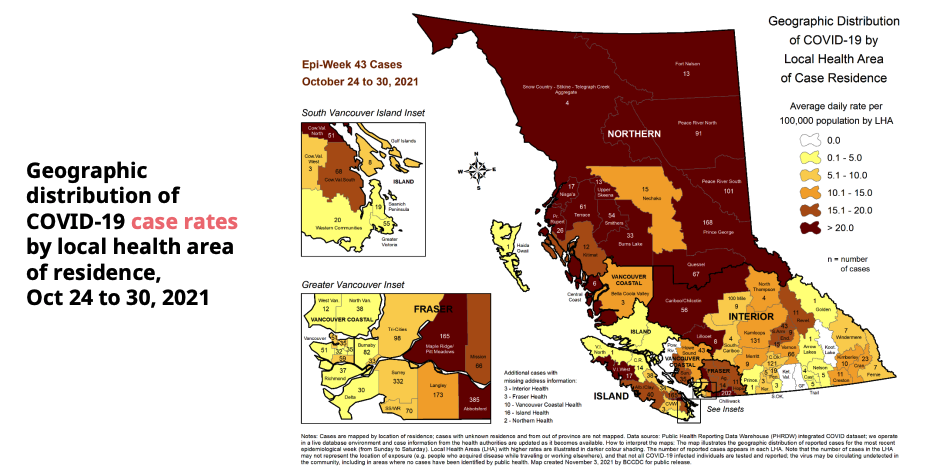
COVID-19 case rates by local health area between October 24 and 30, 2021 (BC Gov).
Cumulative data from January 1, 2020, also shows the difference in how some areas of the province have been more impacted than others — namely, areas of Fraser Health such as Surrey and Abbotsford.
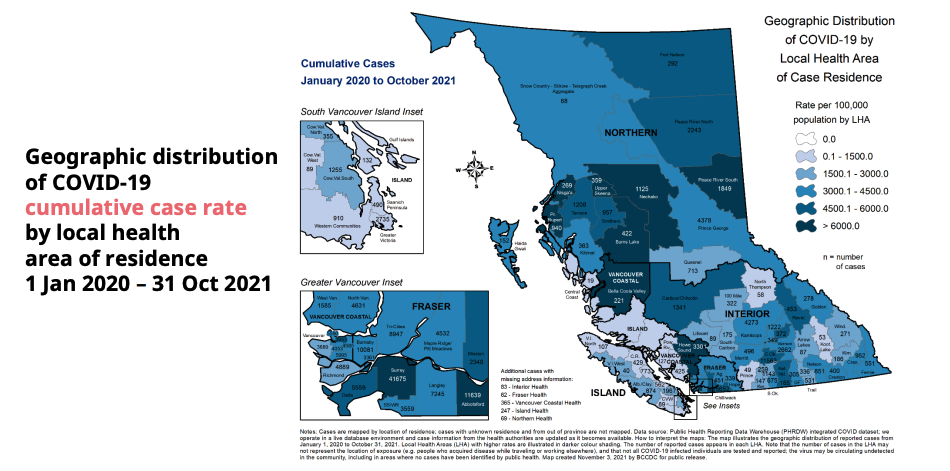
Cumulative COVID-19 case rates by local health area from January 1, 2020, to October 31, 2021 (BC Gov).
Data also shows that vaccination coverage is becoming increasingly high, with over 90% of people in BC age 12 and up being vaccinated. Henry says that there’s a strong correlation between pockets of the province with lower vaccination rates and those with increased transmission.
The province continues to see “stubbornly” high rates of hospitalizations, which Henry partially attributes to the Delta strain of the virus.
“People have asked … what is it that’s keeping hospital rates up — why is there so many cases in transmission,” she explains. “Part of the answer is the strain of the virus that’s circulating right now is that much more transmissible and causing more severe illness in younger people and people who are not vaccinated.”
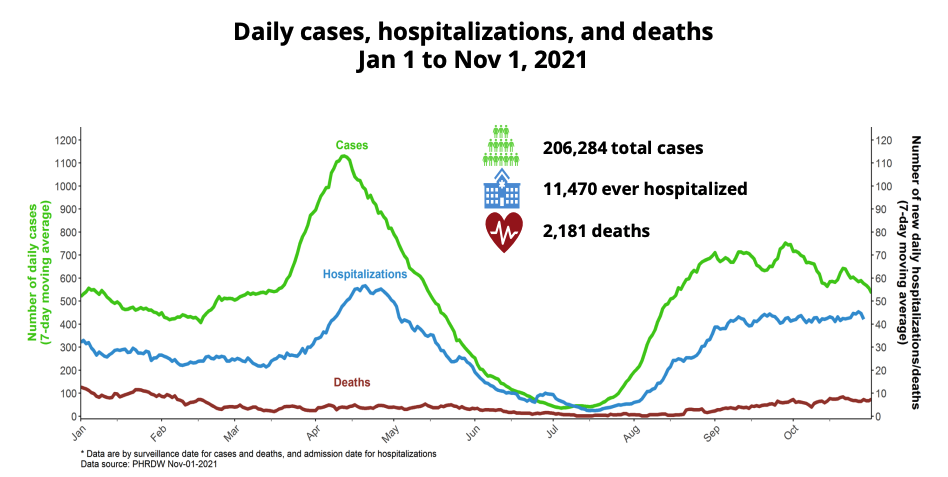
Daily cases, hospitalizations, and deaths from January 1 to November 1, 2021 (BC Gov).
But data also shows that the difference in cases and hospitalizations is “stark” between individuals who are vaccinated and unvaccinated.
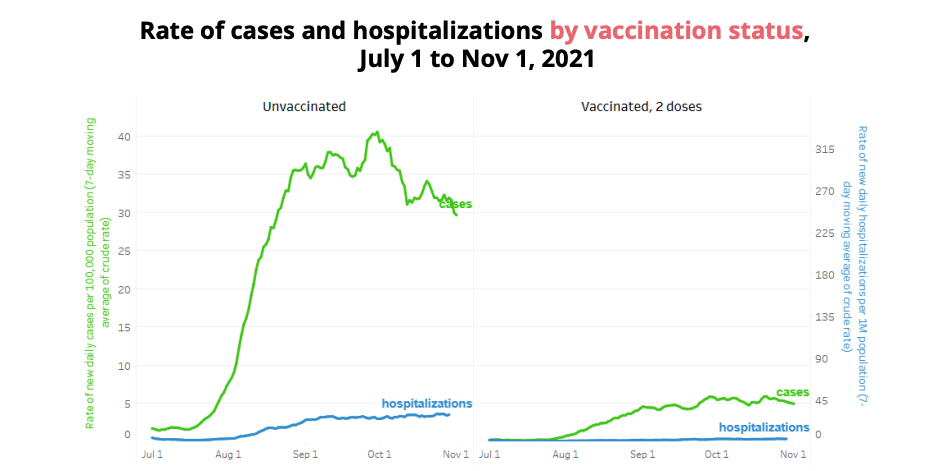
The rate of COVID-19 cases and hospitalizations based on vaccination status from July 1 to November 1, 2021 (BC Gov).
When it comes to COVID-19 testing, rates also remain high. And what officials are starting to see is a decrease in test positivity and case incidence in areas such as the Interior and, more recently, parts of the North.
And while Fraser Health still sees the bulk of new cases, BC’s latest wave was predominantly driven by Interior Health, which has since settled down, and recent cases across Northern Health.
In September, there was also an increase in COVID-19 cases amongst school-aged children, but Henry says it has gone down. There’s also an overall decrease across the board, except in people over the age of 80.
This includes people over the age of 80 who reside in long-term care homes, as well as older adults in the community who are not yet vaccinated.
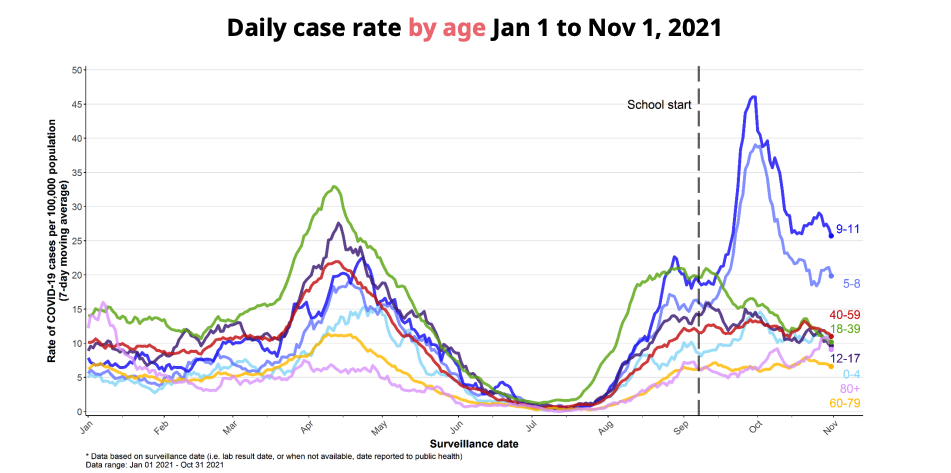
Daily COVID-19 case rates by age from January 1 to November 1, 2021 (BC Gov).
Another point that Henry stressed is that the small number of people in the province who are unvaccinated still has a remarkable impact on BC’s healthcare system.
When looking at cases, hospitalizations, and deaths over the past month, 60% of cases occurred in people who were unvaccinated. But individuals who are unvaccinated only represent 10% of the province over the age of 12.
Henry adds that about half of people who died from COVID-19 were not vaccinated and were younger people.

Data shows that during October, unvaccinated individuals accounted for 72% of hospitalizations (BC Gov).
“A 50-year-old person who is unvaccinated has a 10 times increased risk as a person who is fully vaccinated from getting infected with COVID,” she said.
“These are the important things that help us understand how these vaccines are working and how they’re protecting people.”

Risk of infection, hospitalization, or death from COVID-19 in unvaccinated individuals compared to fully vaccinated individuals (BC Gov).
One positive takeaway in the modelling is that the virus’ reproductive number is below one in most parts of the province. This means that every person who is infected with COVID-19 is likely to pass it on to less than one person.
And while the decrease in transmission is good news, Henry stressed that it was a “fragile balance.”
“For the first time in several months, across the board, we’ve dipped down below one,” she says. “That’s good news. But it’s just below one.”
“Which means that we have, right now, a fragile balance. We’re going down slowly. It is important to recognize that the things we’re doing to prevent transmission… these are all the things that are making a difference right now.”

Dynamic modelling suggests a slight decrease in Rt in several health regions, except for the Interior (BC Gov).
Henry added that “this is not the time to let off in any way,” with BC entering respiratory illness season.
When using dynamic modelling to look forward, Henry was also optimistic in saying that BC should see a slow decline in COVID-19 transmission throughout November.
“We’re looking at the shorter term implications,” she says. “Where we are right now, we should continue to see a steady decline in cases and hospitalizations over the next month. But this is a fragile balance that we’re in.”

COVID-19 transmission scenarios in BC from October 27 to November 29, 2021 (BC Gov).
She stressed that without vaccination, BC would have been in a very different scenario, with modelling showing a reproductive number well above three.
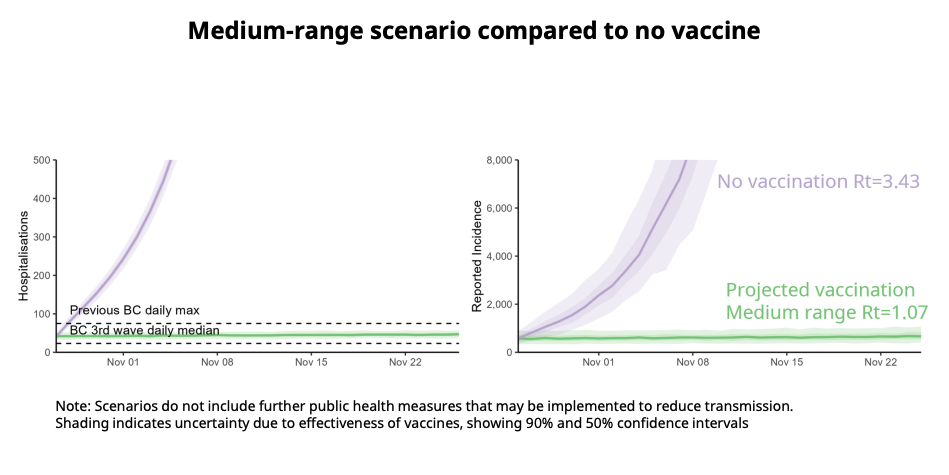
BC’s projected hospitalizations and incidence rate without vaccinations (BC Gov).

